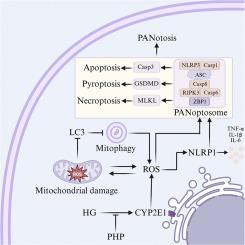Pseudostellaria heterophylla polysaccharides attenuate diabetic lower limb ischemia via CYP2E1-mediated mitochondrial homeostasis and PANoptosis regulation
IF 8.3
1区 医学
Q1 CHEMISTRY, MEDICINAL
引用次数: 0
Abstract
Background
Diabetes mellitus (DM) and its complications pose a significant threat to human health. Diabetes-related lower limb ischemia (DLLI), as a severe complication of diabetic macrovascular disease, presents substantial challenges in clinical management.
Purpose
The pharmacodynamic profile and mode of action of Pseudostellaria heterophylla polysaccharides (PHP) in DLLI treatment constitute the core investigative objectives herein.
Study Design
Using complementary in vivo (DLLI murine model) and in vitro (high glucose (HG)-exposed human umbilical vein endothelial cells (HUVECs)) systems, PHP's bioactivity was systematically profiled.
Methods
In vivo: The effects of PHP on blood perfusion, microvessel density, and PANoptosome assembly in the ischemic limbs of DLLI mice were evaluated.
In vitro: HUVECs treated with HG were used to assess PHP’s regulatory effects on angiogenesis functions (cell migration, proliferation, tube formation), PANoptosome/inflammasome formation, key components of the PANoptotic pathway, reactive oxygen species (ROS/mtROS), mitochondrial homeostasis, and autophagy. Transcriptomic analysis was conducted to identify potential target genes.
Results
In vivo: PHP significantly improved blood perfusion, increased microvessel density, and modulated PANoptosome assembly in ischemic limbs.
In vitro: PHP reversed HG-induced angiogenesis dysfunction, inhibited PANoptosis and oxidative stress, restored mitochondrial function, and enhanced autophagic activity.
Mechanism: PHP exerted its effects by targeting cytochrome P450 enzyme CYP2E1 through downregulating its expression, thereby alleviating mitochondrial damage and PANoptosis. Additionally, CYP2E1 downregulation promoted endothelial cell migration.
Conclusion
We pioneered a PANoptosome-centric framework for DLLI, proving that PHP target CYP2E1 to restore mitochondrial homeostasis, inhibit PANoptosis, and drive angiogenesis, thereby offering a novel natural product-derived therapeutic strategy. Collectively, this work establishes PHP as a promising candidate for DLLI treatment through CYP2E1-mediated restoration of mitochondrial homeostasis and PANoptosis suppression.

太子参多糖通过cyp2e1介导的线粒体稳态和PANoptosis调节减轻糖尿病下肢缺血
糖尿病(DM)及其并发症严重威胁着人类的健康。糖尿病相关性下肢缺血(DLLI)作为糖尿病大血管疾病的严重并发症,在临床治疗中面临着巨大挑战。目的研究太子参多糖(PHP)治疗DLLI的药效学特征和作用方式。采用互补的体内(DLLI小鼠模型)和体外(高糖(HG)暴露的人脐静脉内皮细胞(HUVECs))系统,系统地分析了PHP的生物活性。方法在体内:观察PHP对DLLI小鼠缺血肢体血流灌注、微血管密度和PANoptosome组装的影响。体外实验:用HG处理HUVECs来评估PHP对血管生成功能(细胞迁移、增殖、管形成)、PANoptosome/inflammasome形成、panoptopathway关键组分、活性氧(ROS/mtROS)、线粒体稳态和自噬的调节作用。转录组学分析鉴定潜在靶基因。结果在体内:PHP能显著改善缺血肢体的血流灌注,增加微血管密度,调节PANoptosome的组装。体外:PHP逆转hg诱导的血管生成功能障碍,抑制PANoptosis和氧化应激,恢复线粒体功能,增强自噬活性。机制:PHP通过下调细胞色素P450酶CYP2E1的表达,从而减轻线粒体损伤和PANoptosis,发挥其作用。此外,CYP2E1下调可促进内皮细胞迁移。我们率先建立了以panoptosomes为中心的DLLI框架,证明PHP靶向CYP2E1恢复线粒体稳态,抑制PANoptosis,并驱动血管生成,从而提供了一种新的天然产物衍生的治疗策略。总的来说,这项工作通过cyp2e1介导的线粒体稳态恢复和PANoptosis抑制,确立了PHP作为DLLI治疗的有希望的候选药物。
本文章由计算机程序翻译,如有差异,请以英文原文为准。
求助全文
约1分钟内获得全文
求助全文
来源期刊

Phytomedicine
医学-药学
CiteScore
10.30
自引率
5.10%
发文量
670
审稿时长
91 days
期刊介绍:
Phytomedicine is a therapy-oriented journal that publishes innovative studies on the efficacy, safety, quality, and mechanisms of action of specified plant extracts, phytopharmaceuticals, and their isolated constituents. This includes clinical, pharmacological, pharmacokinetic, and toxicological studies of herbal medicinal products, preparations, and purified compounds with defined and consistent quality, ensuring reproducible pharmacological activity. Founded in 1994, Phytomedicine aims to focus and stimulate research in this field and establish internationally accepted scientific standards for pharmacological studies, proof of clinical efficacy, and safety of phytomedicines.
 求助内容:
求助内容: 应助结果提醒方式:
应助结果提醒方式:


